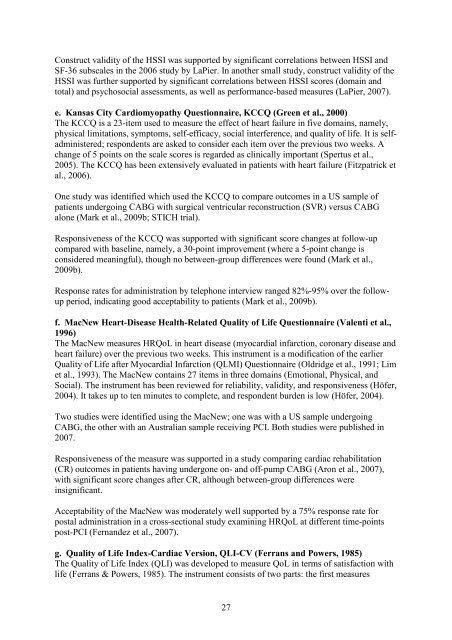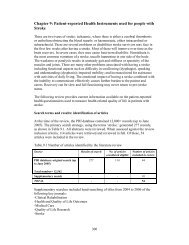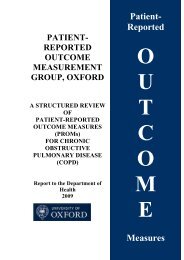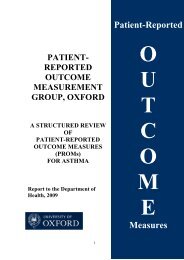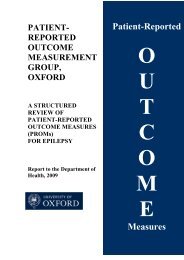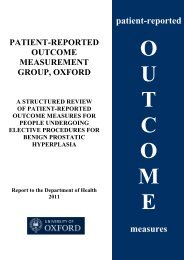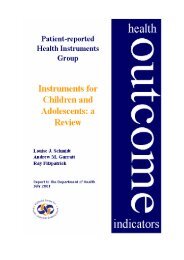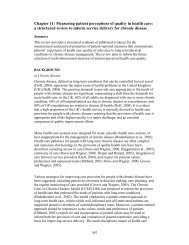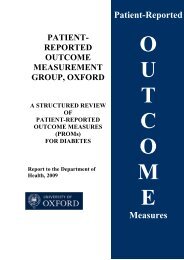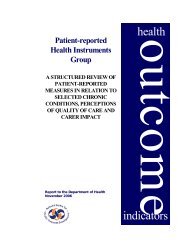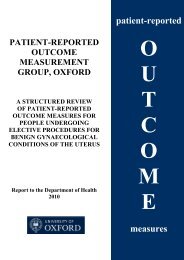2010 review - Patient-Reported Outcomes Measurement - University ...
2010 review - Patient-Reported Outcomes Measurement - University ...
2010 review - Patient-Reported Outcomes Measurement - University ...
You also want an ePaper? Increase the reach of your titles
YUMPU automatically turns print PDFs into web optimized ePapers that Google loves.
Construct validity of the HSSI was supported by significant correlations between HSSI and<br />
SF-36 subscales in the 2006 study by LaPier. In another small study, construct validity of the<br />
HSSI was further supported by significant correlations between HSSI scores (domain and<br />
total) and psychosocial assessments, as well as performance-based measures (LaPier, 2007).<br />
e. Kansas City Cardiomyopathy Questionnaire, KCCQ (Green et al., 2000)<br />
The KCCQ is a 23-item used to measure the effect of heart failure in five domains, namely,<br />
physical limitations, symptoms, self-efficacy, social interference, and quality of life. It is selfadministered;<br />
respondents are asked to consider each item over the previous two weeks. A<br />
change of 5 points on the scale scores is regarded as clinically important (Spertus et al.,<br />
2005). The KCCQ has been extensively evaluated in patients with heart failure (Fitzpatrick et<br />
al., 2006).<br />
One study was identified which used the KCCQ to compare outcomes in a US sample of<br />
patients undergoing CABG with surgical ventricular reconstruction (SVR) versus CABG<br />
alone (Mark et al., 2009b; STICH trial).<br />
Responsiveness of the KCCQ was supported with significant score changes at follow-up<br />
compared with baseline, namely, a 30-point improvement (where a 5-point change is<br />
considered meaningful), though no between-group differences were found (Mark et al.,<br />
2009b).<br />
Response rates for administration by telephone interview ranged 82%-95% over the followup<br />
period, indicating good acceptability to patients (Mark et al., 2009b).<br />
f. MacNew Heart-Disease Health-Related Quality of Life Questionnaire (Valenti et al.,<br />
1996)<br />
The MacNew measures HRQoL in heart disease (myocardial infarction, coronary disease and<br />
heart failure) over the previous two weeks. This instrument is a modification of the earlier<br />
Quality of Life after Myocardial Infarction (QLMI) Questionnaire (Oldridge et al., 1991; Lim<br />
et al., 1993). The MacNew contains 27 items in three domains (Emotional, Physical, and<br />
Social). The instrument has been <strong>review</strong>ed for reliability, validity, and responsiveness (Höfer,<br />
2004). It takes up to ten minutes to complete, and respondent burden is low (Höfer, 2004).<br />
Two studies were identified using the MacNew; one was with a US sample undergoing<br />
CABG, the other with an Australian sample receiving PCI. Both studies were published in<br />
2007.<br />
Responsiveness of the measure was supported in a study comparing cardiac rehabilitation<br />
(CR) outcomes in patients having undergone on- and off-pump CABG (Aron et al., 2007),<br />
with significant score changes after CR, although between-group differences were<br />
insignificant.<br />
Acceptability of the MacNew was moderately well supported by a 75% response rate for<br />
postal administration in a cross-sectional study examining HRQoL at different time-points<br />
post-PCI (Fernandez et al., 2007).<br />
g. Quality of Life Index-Cardiac Version, QLI-CV (Ferrans and Powers, 1985)<br />
The Quality of Life Index (QLI) was developed to measure QoL in terms of satisfaction with<br />
life (Ferrans & Powers, 1985). The instrument consists of two parts: the first measures<br />
27


